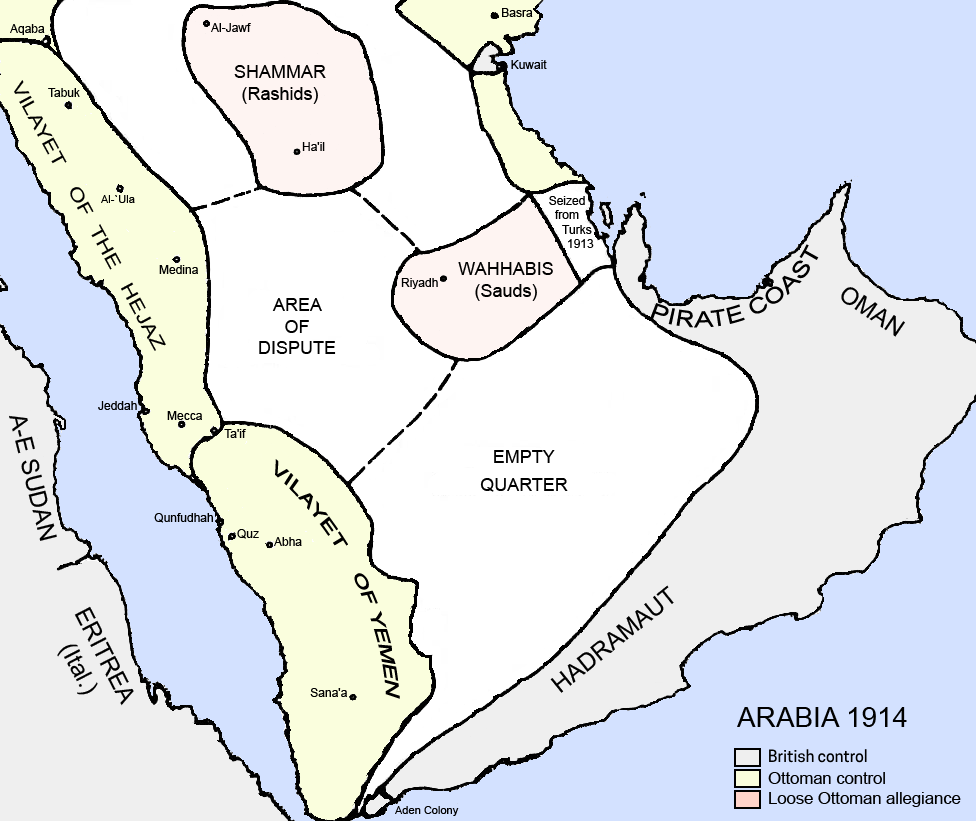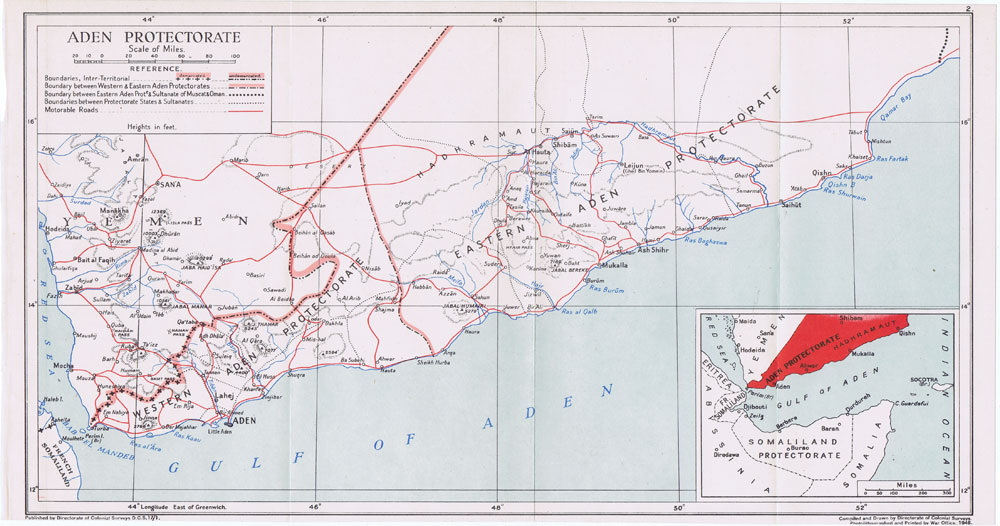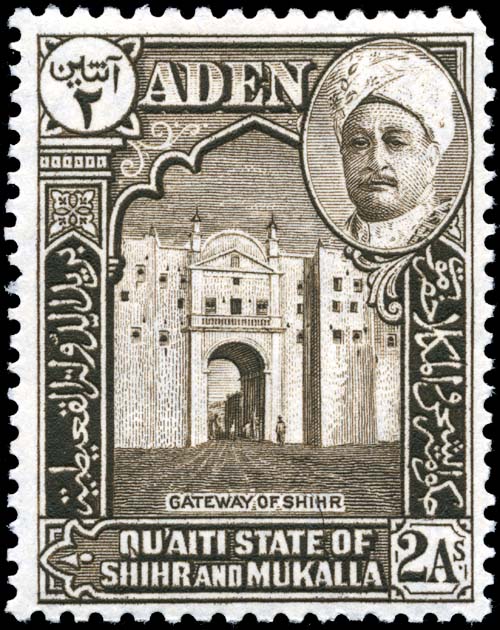|
Qu'aiti
Qu'aiti, ar, ظ±ظ„ظ’ظ‚ظڈط¹ظژظٹظ’ط·ظگظٹ '), officially the Qu'aiti State of Shihr and Mukalla ( ar, ظ±ظ„ط¯ظژظ‘ظˆظ’ظ„ظژط© ظ±ظ„ظ’ظ‚ظڈط¹ظژظٹظ’ط·ظگظٹظژظ‘ط© ظ±ظ„ظ’طظژط¶ظ’ط±ظژظ…ظگظٹظژظ‘ط©, Ad-Dawlah Al-Quت؟ayل¹iyyah Al-ل¸¤aل¸چramiyyah or the Qu'aiti Sultanate of Shihr and Mukalla, ar, ظ±ظ„ط³ظژظ‘ظ„ظ’ط·ظژظ†ظژط© ظ±ظ„ظ’ظ‚ظڈط¹ظژظٹظ’ط·ظگظٹظژظ‘ط© ظپظگظٹ ظ±ظ„ط´ظگظ‘طظ’ط± ظˆظژظ±ظ„ظ’ظ…ظڈظƒظژظ„ظژظ‘ط§ ' was a sultanate in the Hadhramaut region of the southern Arabian Peninsula, in what is now Yemen. Its capital was Mukalla, and it was divided into six provinces including Al-Mukalla, Ash-Shihr, Shibam, Du'an, the Western Province and Hajr. Apart from Al-Mukalla, Ash-Shihr and Shibam were the Sultanate's major cities. The Sultanate spanned the Indian Ocean coast up to the border of Mahra, encompassed Shabwa, the central valleys and oasis settlements of Hadhramaut, and controlled the southern Empty Quarter. History Sons of Umar bin Awadh al Qu'aiti, who became a jemadar in the forces of the Niza ... [...More Info...] [...Related Items...] OR: [Wikipedia] [Google] [Baidu] |
Ghalib II Bin Awadh Al-Qu'aiti
Sultan Ghalib II bin Awadh al-Qu'aiti al-Hadhrami (born 7 January 1948) is the former sultan of the Qu'aiti State or Qu'aiti Sultanate, in modern Yemen, and the current head of the Al-Qu'aiti household. The once ruling Qu’aiti dynasty of Hadramaut was Yafa’i in origin. He reigned from 11 October 1966 until the monarchy was ousted by communists on 17 September 1967. Sultan Ghalib was born in London, United Kingdom, and is the eldest son of his predecessor, Sultan Awadh bin Saleh. His coronation took place 10 June 1967. After his forced abdication, Ghalib married Sultana Rashid Ahmed on 7 June 1975, with whom he has fathered one son, Prince Saleh and two daughters, Princess Fatima and Princess Muzna. Sultan Ghalib holds an MA from the University of Oxford in Oriental Studies (Islamic History) and another in Arabian Studies from the University of Cambridge, both with honours. The Sultan graduated from Millfield School Millfield is a public school (English independent day ... [...More Info...] [...Related Items...] OR: [Wikipedia] [Google] [Baidu] |
Protectorate Of South Arabia
The Protectorate of South Arabia consisted of various states located at the southern end of the Arabian Peninsula under treaties of protection with Britain. The area of the former protectorate became part of South Yemen after the Radfan uprising and is now part of the Republic of Yemen. History Background The background of the Protectorate of South Arabia is part of an effort of the British Empire to protect the East India Route, the sea route between the Mediterranean Sea and India, in and through the southern coasts of Arabia. Already before the opening of the Suez Canal, industrial Britain with its rapidly expanding economy, needed improved communication with British India. The coastal plains of the peninsula had been devastated earlier in the 19th century by Wahhabi puritan Muslims from Central Arabia followed by an Egyptian invasion. From the first commercial treaty with the Sultanate of Lahej in 1802, various efforts were made to avoid looting of East India ships, ... [...More Info...] [...Related Items...] OR: [Wikipedia] [Google] [Baidu] |
Hadhramaut
Hadhramaut ( ar, طظژط¶ظ’ط±ظژظ…ظژظˆظ’طھظڈ \ طظژط¶ظ’ط±ظژظ…ظڈظˆطھظڈ, ل¸¤aل¸چramawt / ل¸¤aل¸چramإ«t; Hadramautic: ًگ©¢ًگ©³ًگ©§ًگ©£ًگ©©, ''ل¸¤ل¸چrmt'') is a region in South Arabia, comprising eastern Yemen, parts of western Oman and southern Saudi Arabia. The name is of ancient origin, and is retained in the name of the Yemeni Governorate of Hadhramaut. The people of Hadhramaut are called Hadhrami. They formerly spoke Hadramautic, an old South Arabian language, but they now predominantly speak Hadhrami Arabic, which has much influence from Hadramautic. Etymology The origin of the name of ''ل¸¤aل¸چramawt'' is not exactly known, and there are numerous competing hypotheses about its meaning. The most common folk etymology is that the region's name means "death has come," from ar, طظژط¶ظژط±, ل¸¥aل¸چara, lit=he came and ar, ظ…ظژظˆظ’طھ, mawt, lit=death, though there are multiple explanations for how it came to be known as such. One explanation is that this is a nickname of 'A ... [...More Info...] [...Related Items...] OR: [Wikipedia] [Google] [Baidu] |
Aden Protectorate
The Aden Protectorate ( ar, ظ…طظ…ظٹط© ط¹ط¯ظ† ') was a British protectorate in South Arabia which evolved in the hinterland of the port of Aden and in the Hadhramaut following the conquest of Aden by the Bombay Presidency of British India in 1839, and it continued until the 1960s. In 1940 it was divided for administrative purposes into the Western Protectorate and the Eastern Protectorate. Today the territory forms part of the Republic of Yemen. The rulers of the Aden Protectorate, as generally with the other British protectorates and protected states, remained sovereign: their flags still flew over their government buildings, government was still carried out by them or in their names, and their states maintained a distinct 'international personality' in the eyes of international law, in contrast to states forming part of the British Empire, such as Aden Colony, where the British monarch was the head of every state. History Informal beginnings What became known as the ... [...More Info...] [...Related Items...] OR: [Wikipedia] [Google] [Baidu] |
Kathiri
Kathiri ( ar, ظ±ظ„ظ’ظƒظژط«ظگظٹظ’ط±ظگظٹ, al-Kathؤ«rؤ«), officially the Kathiri State of Seiyun ( ar, ظ±ظ„ط³ظژظ‘ظ„ظ’ط·ظژظ†ظژط© ظ±ظ„ظ’ظƒظژط«ظگظٹظ’ط±ظگظٹظژظ‘ط© - ط³ظژظٹظ’ط¤ظڈظˆظ’ظ†, al-Salل¹anah al-Kathؤ«rؤ«yah - Sayت¾إ«n), was a sultanate in the Hadhramaut region of the southern Arabian Peninsula, in what is now part of Yemen and the Dhofari region of Oman. History The Kathiri State was established in 1395 by Badr as-Sahab ibn al-Habrali Bu Tuwairik, who ruled until . The Kathiri conquered Ash-Shihr in the 1460s. The country inhabited by this tribe was formerly extensive, reaching from the Aulaqi districts on the west to the Maliri tribe on the east, and including the seaports of Mukalla and Shihr. Civil wars led to the interference of the Yafai, and much of the Kathiri territory came under the sway of the Kasadi and Qu'aiti. The Kathiris were eventually restricted to a small inland portion of Hadhramaut with their capital at Seiyun (Say'un). At the end of 1883, Sultan Abdul ... [...More Info...] [...Related Items...] OR: [Wikipedia] [Google] [Baidu] |
Ash-Shihr
Ash-Shihr ( ar, ظ±ظ„ط´ظگظ‘طظ’ط±, al-Shiل¸¥r), also known as al-Shir or simply Shihr, is a coastal town in Hadhramaut, eastern Yemen. Ash-Shihr is a walled town located on a sandy beach. There is an anchorage but no docks; boats are used. The main export is fish oil. The town is divided in two by a '' wؤپdi'' (dry riverbed) called al-Misyؤپl. The western quarter is called Majraf and the eastern al-Ramla. As of 1997 it had several souqs (markets): the Sإ«q al-Lakham, Sإ«q al-Hunإ«d, Sإ«q Shibؤپm, etc. History The history of ash-Shihr (formerly also al-Asت؟ؤپت¾) can be traced back as far as about AD 780., at 47. It was a major port on the incense trade route as an exporter of frankincense to places as far as China. Ibn Khurradؤپdhbih calls the area around ash-Shihr the ''bilؤپd al-kundur'', Land of Incense. It was also known for its ambergris, ''ت؟anbar Shiل¸¥rؤ«''. It was the main port of Hadhramaut until replaced by Mukalla in the 19th century. Local pottery production at Y ... [...More Info...] [...Related Items...] OR: [Wikipedia] [Google] [Baidu] |
Mukalla
Mukalla ( ar, ظ±ظ„ظ’ظ…ظڈظƒظژظ„ظژظ‘ط§, ') is a seaport and the capital city of Yemen's largest governorate, Hadhramaut. The city is in the southern part of the Arabian Peninsula on the Gulf of Aden, on the shores of the Arabian Sea, about east of Aden. It is the most important port in the Hadhramaut and the fifth-largest city in Yemen, with a population of approximately 500,000. The city is served by the nearby Riyan International Airport. History Mukalla is not far from Cane or Qana, the ancient principal Hadrami trading post between India and Africa, with incense producing areas in its hinterland. Mukalla was founded in 1035 as a fishing settlement. This area was part of Oman until the middle of the 11th century, and later this area became part of Yemen. After witnessing a struggle for control by the Kathiri and Qu'aiti Sultanates in the 19th and 20th centuries, it became the capital of the Qu'aiti State of Hadhramaut, and then in 1967, it became a part of South Yemen. ... [...More Info...] [...Related Items...] OR: [Wikipedia] [Google] [Baidu] |
South Arabia
South Arabia () is a historical region that consists of the southern region of the Arabian Peninsula in Western Asia, mainly centered in what is now the Republic of Yemen, yet it has also historically included Najran, Jizan, Al-Bahah, and 'Asir, which are presently in Saudi Arabia, and the Dhofar of present-day Oman. South Arabia is inhabited by people possessing distinctive linguistic and ethnic affinities, as well as traditions and culture, transcending recent political boundaries. There are two indigenous language groups: the now extinct Old South Arabian languages and the unrelated Modern South Arabian languages, both members of the Semitic family. Etymology The term ''Yamnat'' was mentioned in Old South Arabian inscriptions on the title of one of the kings of the second Himyarite Kingdom known as Shammar Yahrت½ish II. The term was probably referring to the southwestern coastline of the Arabian peninsula and the southern coastline between Aden and Hadramout. One ety ... [...More Info...] [...Related Items...] OR: [Wikipedia] [Google] [Baidu] |
Sultan
Sultan (; ar, ط³ظ„ط·ط§ظ† ', ) is a position with several historical meanings. Originally, it was an Arabic abstract noun meaning "strength", "authority", "rulership", derived from the verbal noun ', meaning "authority" or "power". Later, it came to be used as the title of certain rulers who claimed almost full sovereignty (i.e., not having dependence on any higher ruler) without claiming the overall caliphate, or to refer to a powerful governor of a province within the caliphate. The adjectival form of the word is "sultanic", and the state and territories ruled by a sultan, as well as his office, are referred to as a sultanate ( '. The term is distinct from king ( '), despite both referring to a sovereign ruler. The use of "sultan" is restricted to Muslim countries, where the title carries religious significance, contrasting the more secular ''king'', which is used in both Muslim and non-Muslim countries. Brunei and Oman are the only independent countries which retain the ti ... [...More Info...] [...Related Items...] OR: [Wikipedia] [Google] [Baidu] |
Sultanate
This article includes a list of successive Islamic states and Muslim dynasties beginning with the time of the Islamic prophet Muhammad (570–632 CE) and the early Muslim conquests that spread Islam outside of the Arabian Peninsula, and continuing through to the present day. The first-ever establishment of an Islamic polity goes back to the Islamic State of Medina, which was established by Muhammad in the city of Medina in 622 CE. Following his death in 632 CE, his immediate successors established the Rashidun Caliphate, which was further succeeded by the Umayyad Caliphate and later the Abbasid Caliphate. While the primary caliphates gradually fractured and fell, other Muslim dynasties rose; some of these dynasties established notable and prominent Islamic empires, such as the Ottoman Empire centered around Anatolia, the Safavid Empire of Persia, and the Mughal Empire in India. Middle East and North Africa Mesopotamia and Levant (Iraq, Jordan, Lebanon, Palestine, Syria) *U ... [...More Info...] [...Related Items...] OR: [Wikipedia] [Google] [Baidu] |
Shibam
Shibam Hadramawt ( ar, ط´ظگط¨ظژط§ظ… طظژط¶ظ’ط±ظژظ…ظژظˆظ’طھ, Shibؤپm ل¸¤aل¸چramawt) is a town in Yemen. With about 7,000 inhabitants, it is the seat of the District of Shibam in the Governorate of Hadhramaut. Known for its mudbrick-made high-rise buildings, it is referred to as the "Chicago of the Desert" (), or "Manhattan of the Desert" (). History The first known inscription about the city dates from the 3rd century CE. It was the capital of the Hadramawt Kingdom. In the 20th century, it was one of the three major cities of the Qu'aiti Sultanate, the others being Al-Mukalla and Ash-Shihr. The city was listed with the UNESCO World Heritage List, in 1982.Bricks and mortar fire: Yemen’s cultural heritage is in the c ... [...More Info...] [...Related Items...] OR: [Wikipedia] [Google] [Baidu] |
Federation Of South Arabia
The Federation of South Arabia ( ar, ط§طھطط§ط¯ ط§ظ„ط¬ظ†ظˆط¨ ط§ظ„ط¹ط±ط¨ظٹ ') was a federal state under British protection in what would become South Yemen. Its capital was Aden. It was formed on 4 April 1962 from the 15 protected states of the Federation of Arab Emirates of the South. The State of Aden, formerly Aden Colony, joined the Federation on 18 January 1963. In June 1964, the Upper Aulaqi Sultanate was added for a total of 17 states. A team was sent to the 1966 Commonwealth Games in Kingston, Jamaica. The Federation was abolished on 30 November 1967, when its status as a British protectorate came to an end, along with that of the Protectorate of South Arabia, and they became the People's Democratic Republic of Yemen. States * Aden * Alawi * Aqrabi * Audhali * Beihan * Dathina * Dhala * Fadhli * Haushabi * Lahej * Lower Aulaqi * Lower Yafa * Maflahi * Shaib * Upper Aulaqi Sheikhdom * Upper Aulaqi Sultanate * Wahidi Balhaf Leaders Chief Ministers * Has ... [...More Info...] [...Related Items...] OR: [Wikipedia] [Google] [Baidu] |

.jpg)





